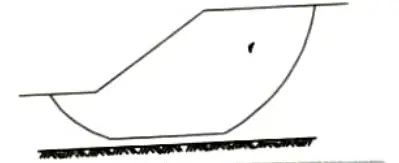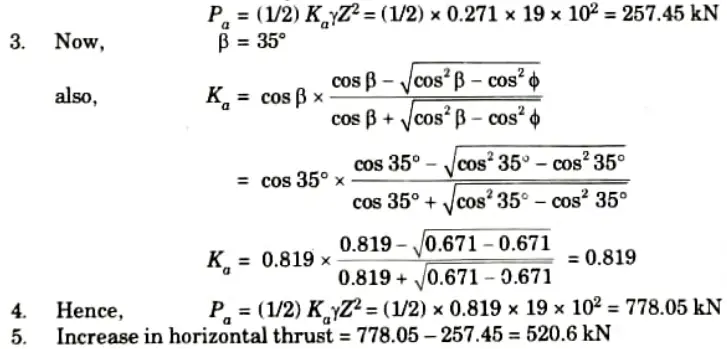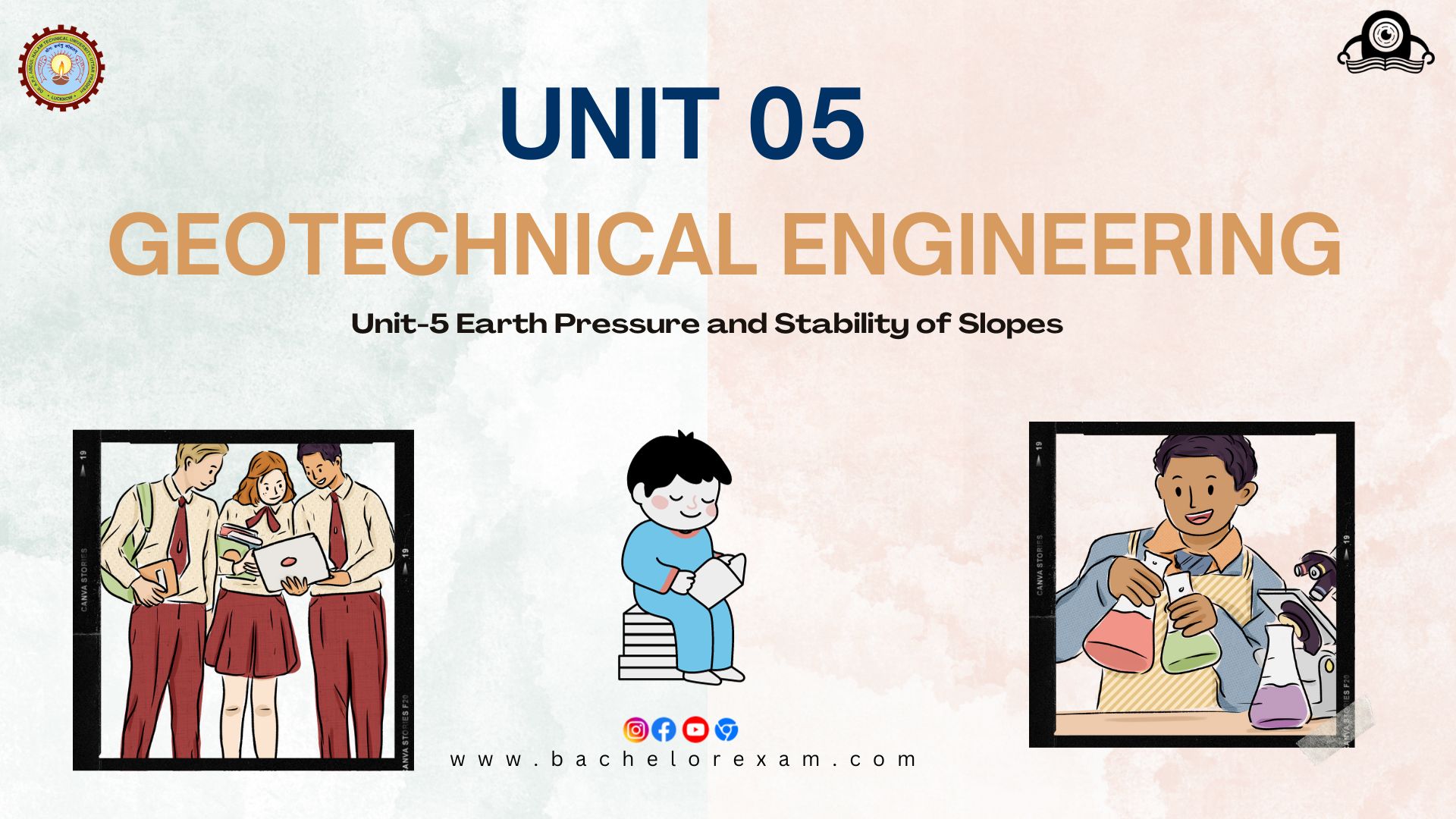Aktu Btech Quantum Notes will help you prepare for the Geotechnical Engineering test. These critical, frequently asked questions and thorough information are your road map to success. Improve your knowledge right now! Unit-5 Earth Pressure and Stability of Slopes
Dudes 🤔.. You want more useful details regarding this subject. Please keep in mind this as well. Important Questions For Geotechnical Engineering: *Quantum *B.tech-Syllabus *Circulars *B.tech AKTU RESULT * Btech 3rd Year * Aktu Solved Question Paper
Q1. What are the different types of earth pressure ? Give examples.
Ans. Types of Earth Pressure: Lateral earth pressure can be grouped into three categories, depending upon the movement of the retaining wall with respect to the soil retained:
1. At-rest Pressure:
- i. When the soil mass is not subjected to any lateral yielding or movement, the lateral earth pressure is referred to as at-rest pressure.
- ii. This situation arises when the retaining wall’s top is set securely and cannot rotate or move laterally.
- iii. In Fig. (a), the basement retaining walls are shown. The basement slab is given at the top of the walls to prevent movement.
2. Active Pressure:
- i. The soil mass enters a condition of active pressure when it yields in a way that causes it to tend to extend horizontally.
- ii. When a retaining wall is moved away from the backfill, the soil mass stretches and the earth pressure is in an active state.
- iii. The active pressure in Fig. (b) develops on the right side as the wall advances to the left.
3. Passive Pressure:
- i. When the wall is moving in a way that causes the soil to naturally compress horizontally, a state of passive pressure is present.
- ii. As shown in Fig. (b), when the wall moves to the right, passive pressure forms on the left side of the wall below ground level due to soil compression.



Q2. What are the various assumptions in Coulomb’s theory? Also, explain Coulomb’s wedge theory.
Ans. A. Assumptions: Following are the basic assumptions of the Coulomb’s theory or wedge theory:
- 1. The backfill is dry and cohesionless.
- 2. Soil is homogenous, isotropic, and semi-infinite.
- 3. The wall’s back, which is in contact with the backfill, may be vertical or inclined and is uneven.
- 4. The failure wedge functions as a rigid body, distributing stresses evenly across it.
- 5. The rupture surface of the two-dimensional failure passes through the heel of the wall.
- 6. Location and direction of resultant thrust is known.
B. Coulomb’s Wedge Theory:
- 1. Coulomb created a method for calculating the earth pressure in which he took into account the sliding wedge’s equilibrium, which is created when the retaining wall moves.
- 2. In the active scenario, the sliding wedge slides outward and downward with respect to the backfill, whereas the sliding wedge moves upward in the passive case.
- 3. To maintain the sliding wedge’s balance, the lateral pressure on the wall must be equal to and in opposition to the reactive force applied by the wall.
- 4. In Coulomb’s theory, a planar failure surface is taken into account, and the lateral force necessary to keep the wedge in equilibrium is calculated using statics principles.
- 5. The process is carried out again on various test surfaces.
- 6. The real failure surface is the trial surface that exerts the greatest force in the active case and the least force in the passive case.
- 7. Compared to the Rankine’s theory, the Coulomb’s theory is more inclusive.
Q3. What are the different types of slope failures?
Ans. Following are the various types of slope failures:
1. Rotational Failure:
- i. As depicted in Fig., this form of failure rotates over a slip surface as the soil mass moves outward and downward.
- ii. In cases of homogenous soil conditions, the slip surface is typically circular, while in cases of non-homogeneous soil conditions, it is non-circular.



2. Translational Failure:
- i. A constant slope of unlimited extent and having uniform soil properties at the same depth below the free surface is known as an infinite slope.



- ii. Translational failure occurs in an infinite slope along a long failure surface parallel to the slope, as shown in Fig.
3. Compound Failure:
- i. A compound failure, as depicted in Fig., combines rotational slips and translational slips.
- ii. A compound failure surface is planar in the middle and bent at the ends.



4. Wedge Failure: As depicted in Fig., a failure along an inclined plane is referred to as a block, wedge, or plane failure. It happens when discrete soil mass wedges and blocks separate from one another.



5. Miscellaneous Failures: In addition to the aforementioned four failure types, spreads and flows are further examples of more complex failure types that can happen.
Q4. Explain the types of slopes of earth surface.
Ans. Types of slopes:
A. On the basis of method of construction:
- 1. Natural Slopes:
- i. Natural slopes are those that have evolved naturally as a result of natural processes.
- ii. Natural slopes are ones that are generated naturally and can be found in the environment. These slopes can be found in hilly places.
- 2. Artificial Slopes:
- i. The slopes created by artificial means. Humans create artificial slopes according to specifications.
- ii. The sides of cuttings, the slopes of embankments built for highways, railway lines, canals, etc., and the slopes of earth dams built for water storage are examples of man-made slopes.
- B. On the Basis of Type of Soil :
- 1. Cohesive Soil Slope: Having purely cohesive soil as its content. It is also known as cohesive soil slope.
- 2. Frictional Soil Slope: Slopes having frictional soil as its contents. It is also known as frictional soil slope.
- 3. Cohesive-Frictional Soil Slope: Slopes made up of soil which has both frictional as well as cohesive properties. It is also known as c-𝝓 soil slope.
Q5. Using the Rankine theory, determine the total active thrust on a vertical retaining wall 10 m high if the soil retained has the following properties 𝝓 = 35° : 𝝲 = 19 kN/m.
What is the increase in horizontal thrust if the soil slopes up from the top of the wall at an angle of 35° to the horizontal ?
Ans. 1. The coefficient of active earth pressure (Ka) is given by



2. The lateral active earth pressure,



Q6. Compare Coulomb’s theory and Rankine’s theory.
Ans.
| S. No. | Coulomb’s Theory | Rankine’s Theory |
| 1. | Coulomb considers a retaining wall and the backfill as a system. | Rankine does not consider it. |
| 2. | The back of the wall can be inclined or vertical. | The retaining wall is vertical. |
| 3. | Back of retaining wall is rough. | Back of retaining wall is smooth. |
| 4. | The backfill surface may plane or curved. | This theory allows only for a plane surface. |
| 5. | More versatile. | Less versatile. |
| 6. | More rational and difficult to solve the problems. | Relatively simple and hence is more commonly used. |
| 7. | Pressure magnitude and location are calculated from the concept of wall friction. | Pressure magnitude and location are calculated mathematically. |



Important Question with solutions | AKTU Quantums | Syllabus | Short Questions
Geotechnical Engineering Btech Quantum PDF, Syllabus, Important Questions
| Label | Link |
|---|---|
| Subject Syllabus | Syllabus |
| Short Questions | Short-question |
| Question paper – 2021-22 | 2021-22 |
Geotechnical Engineering Quantum PDF | AKTU Quantum PDF:
| Quantum Series | Links |
| Quantum -2022-23 | 2022-23 |
AKTU Important Links | Btech Syllabus
| Link Name | Links |
|---|---|
| Btech AKTU Circulars | Links |
| Btech AKTU Syllabus | Links |
| Btech AKTU Student Dashboard | Student Dashboard |
| AKTU RESULT (One VIew) | Student Result |
